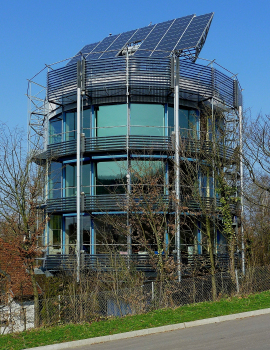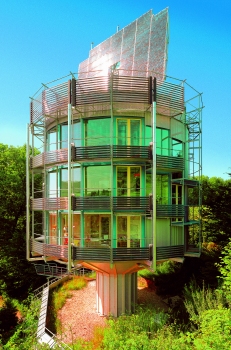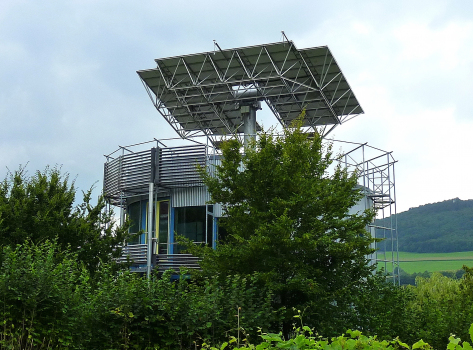General Information
Project Type
| Function / usage: |
Single-family home (detached) |
|---|---|
| Structure: |
Frame |
| Function / usage: |
Experimental structure |
| Energy efficiency: |
for registered users |
| Material: |
Timber structure |
| Energy efficiency: |
for registered users |
Location
| Location: |
Freiburg im Breisgau, Baden-Württemberg, Germany |
|---|---|
| Address: | Ziegelweg |
| Coordinates: | 47° 58' 24" N 7° 49' 60" E |
Technical Information
Dimensions
| height | 24.50 m | |
| useable space | 355 m² | |
| shaft | diameter | 1 m |
Excerpt from Wikipedia
The Heliotrope is an environmentally friendly house designed by the German architect Rolf Disch who also designed the Sonnenschiff (Sun Ship). Three such houses exist in Germany, the first experimental version having been built in 1994 as the architect's home in Freiburg im Breisgau, while the other two are used as exhibition buildings for the Hansgrohe company in Offenburg and a dentist's lab in Hilpoltstein in Bavaria. The Heliotrope in Freiburg was the first building in the world to capture more energy than it uses, all of which is entirely renewable, emissions free and CO2 neutral. The structure physically rotates to track the sun, which allows it to harness the maximum natural sunlight and warmth possible. Several different energy generation modules are used in the building including a 603 sq ft (56.0 m²) dual-axis solar photovoltaic tracking panel, a geothermal heat exchanger, a combined heat and power unit (CHP) and solar-thermal balcony railings to provide heat and warm water. These innovations in combination with the superior insulation of the residence allow the Heliotrope to capture anywhere between four and six times its energy usage depending on the time of year. The Heliotrope is also fitted with a grey-water cleansing system and built-in natural waste composting.
At the same time that Freiburg’s Heliotrope was built, Hansgrohe contracted Rolf Disch Solar Architecture to design and build another Heliotrope to be used as a visitor’s center and showroom in Offenburg, Germany. A third Heliotrope was then contracted and built in Hilpoltstein, Bavaria to be used as a technical dental laboratory. Disch’s unique design accommodates different utilization from private residences to laboratories, and nevertheless maintains the structure’s positive energy balance. In addition to the original Heliotrope design, Rolf Disch has drawn plans for larger versions of the project to be built as a rotating hotel, which gives every guest a beautiful view, as well as administrative buildings and even an exhibition pavilion for the EXPO 2010 in Shanghai.
PlusEnergy
PlusEnergy is a coined concept developed by Rolf Disch that indicates a structure’s extreme energy efficiency so that it holds a positive energy balance, actually obtaining more energy than it uses. With the completion of his private residence, the Heliotrope, in 1994, Disch had created the first PlusEnergy house in the world. The sheer logic of a home that captures more energy than it consumes made perfect sense to Disch. His next goal in its development was thus the mass application of the concept to residential, commercial and retail space. As the concept further developed and gained financial backing as well, Disch built several more projects with PlusEnergy certifications. PlusEnergy is a simple concept that has been materialized in a technical design. “PlusEnergy is a fundamental environmental imperative,” Disch claims. Disch believes that passive building isn’t enough because passive homes still emit CO2 into the atmosphere.
Environment and energy needs
The house is designed to face the sun with its triple-pane windows (U = 0.5) during the heating months of the year and turn its highly insulated back (U = 0.12) to the sun during the warmer months when heating isn't necessary. This significantly reduces heating and cooling requirements for the building throughout the year which are provided for by a heat pump, while hot water is provided by vacuum-tube solar panels.
Photovoltaic solar panels with a rated power of 6.6 kW on its roof provide five to six times more energy than the building uses, making the building energy positive (PlusEnergy). To further improve energy capture, the panels also rotate independently from the building to follow the sun, while being able to adapt its orientation in case of strong winds.
Water usage and natural waste management
In order to limit water usage, a gray water circuit (for washing dishes and clothes) is used. It also collects rainwater. Waste water is purified in a vegetated cascade pond outside of the edifice.
Natural waste and excrement are dry composted in the structure as well.
Inhabitant comfort
One of the main attractions of the house, apart from its low energy needs is its rotating view. As the building turns according to the sun's position, the view changes creating a spectacular view. This feature was later developed into a rotating hotel concept.
The roof deck includes a sun and viewing deck, as well as a garden terrace. The solar panels can be used for sun or rain protection while on the roof terrace.
All floors are accessible from the spiral staircase reducing surface loss through hallways and corridors.
Awards
- 2008 German Sustainability Award
- 2007–08 Japanese PEN-Magazine Creativity Award
- 2005 Wuppertal Energy and Environment Prize
- 2003 Global Energy Award
- 2002 European Solar Prize
- 2001 Photovoltaic Architecture Prize Baden-Württemberg
Further potential
Further potential for this building design includes plans that were drawn up for a possible Heliotrope Hotel. This project currently has no customers but was designed to show that the revolving design can easily be scaled up. The plans for a rotating hotel have surfaced on several occasions although the financing has not yet been available for its actualization.
Text imported from Wikipedia article "Heliotrope (building)" and modified on April 22, 2020 according to the CC-BY-SA 4.0 International license.
Participants
- Rolf Disch (owner)
- Rolf Disch (architect)
- Ehlbeck (checking engineer)
Relevant Web Sites
Relevant Publications
- (1999): Ingenieurbauführer Baden-Württemberg. 1st edition, Bauwerk Verlag, Berlin (Germany), pp. 397-398.
- About this
data sheet - Structure-ID
20059300 - Published on:
29/01/2011 - Last updated on:
03/02/2022







